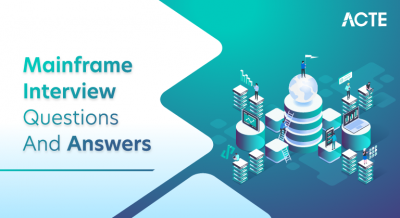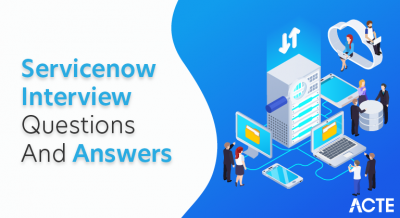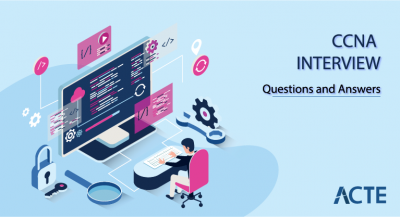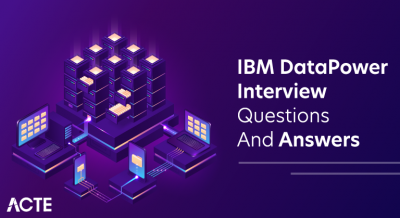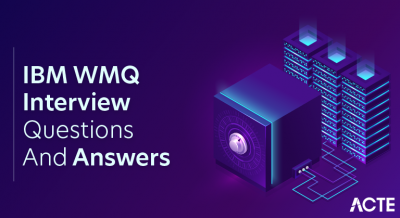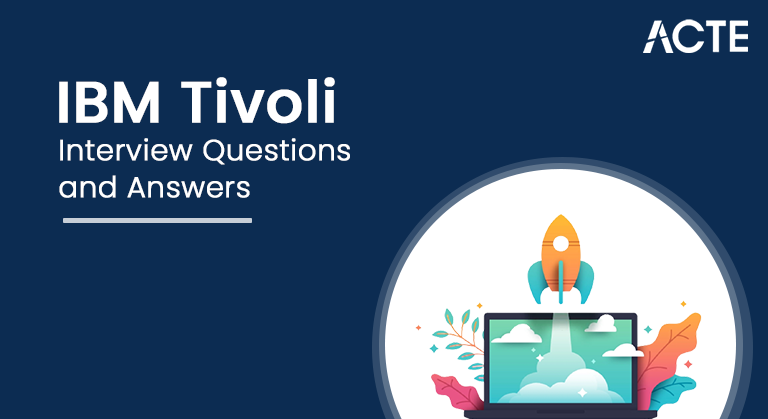
The IBM Tivoli Monitoring (ITM) interview questions provided by ACTE encompass a diverse range of topics related to ITM, designed to assess the candidate’s proficiency in this monitoring solution. These questions likely cover vital aspects such as ITM’s architecture, configuration, customization of monitoring agents, understanding of various monitoring components, troubleshooting techniques, integration with other IBM products, and knowledge of performance tuning and optimization strategies. Candidates may also be evaluated on their familiarity with ITM’s role in managing and monitoring complex IT infrastructures and their ability to apply ITM in real-world scenarios to ensure optimal system performance and reliability. Preparing for these questions would involve thoroughly reviewing ITM concepts, features, and practical implementation scenarios.
1. Explain the key components of IBM Tivoli Monitoring (ITM).
Ans:
- ITM consists of the Tivoli Enterprise Monitoring Server, Tivoli Enterprise Portal Server, and Tivoli Enterprise Portal Client.
- These components work together to collect, process, and display monitoring data.
- Remember, Product details and features may have evolved since then, so it’s a good idea to refer to the latest documentation for the most up-to-date information.
2. How does IBM Tivoli Storage Manager (TSM) ensure data protection?
Ans:
TSM ensures data protection through features like backup, restore, and archive. It provides centralized management for backup policies, scheduling, and storage device management, ensuring the availability and integrity of critical data.is a data protection and backup solution designed to help organizations manage and safeguard their necessary data.
3. How does IBM Tivoli integrate with other IT management tools?
Ans:
IBM Tivoli products often provide integration capabilities through standard protocols and APIs. This allows seamless communication and data exchange with other IT management tools, facilitating a more comprehensive and unified approach to managing the IT environment.
4. Explain the role of IBM Tivoli Configuration Manager (ITCM).
Ans:
Tivoli Configuration Manager is used for configuration management and software distribution. It helps organizations maintain consistency and control over their IT infrastructure by managing configuration settings and distributing software updates.
- Configuration Management
- Inventory Management
- Policy-Based Management
- Automated Configuration Changes
- Change Tracking and Auditing
5. Explain the purpose of IBM Tivoli Netcool/OMNIbus.
Ans:
Tivoli Netcool/OMNIbus is a scalable and extensible event and service management solution. It collects and consolidates events from various sources, providing a unified view of the IT infrastructure and helping organizations to identify and respond to issues efficiently.IBM Tivoli Netcool/OMNIbus, often referred to simply as Netcool, is a software product designed for event and service management.
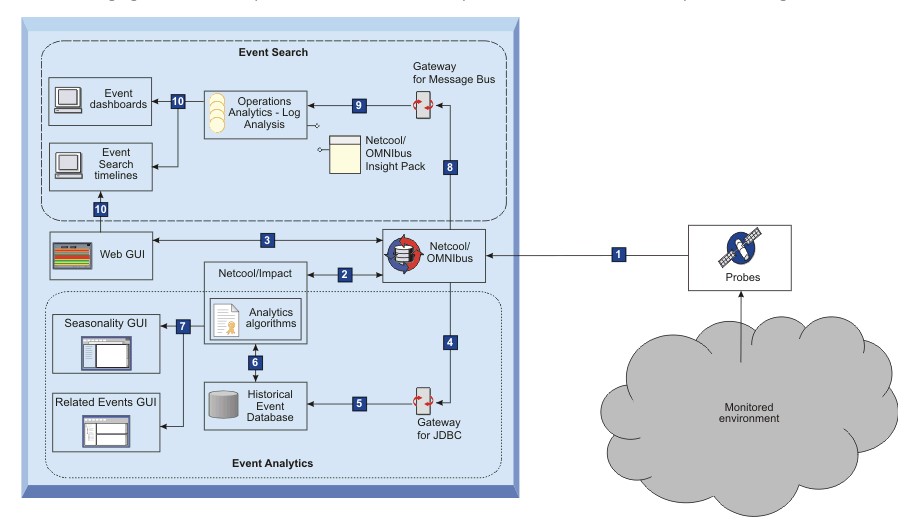
6. What is TEMS in IBM Tivoli Monitoring?
Ans:
TEMS stands for Tivoli Enterprise Monitoring Server. It is responsible for collecting and processing monitoring data from various agents and forwarding the data to the Tivoli Enterprise Portal Server (TEPS) for display.ITM architecture is responsible for collecting, processing, and managing monitoring data from various sources within an IT environment.
7. Can you name some critical components of the IBM Tivoli suite?
Ans:
- Tivoli Monitoring
- Tivoli Storage Manager
- Tivoli Identity Manager
- Tivoli Access Manager
- Tivoli Configuration Manager
8. Explain the role of Tivoli Enterprise Console (TEC)?
Ans:
Tivoli Enterprise Console is a centralized event management system that collects and correlates events from various sources in the IT environment. It provides a unified view of the overall system health and facilitates quick response to issues. the Tivoli Enterprise Console (TEC) is part of the IBM Tivoli Management Framework, which includes various components for managing and monitoring IT environments.
9. How does IBM Tivoli help IT service management (ITSM)?
Ans:
IBM Tivoli supports IT service management by providing tools for monitoring, managing, and optimizing IT resources. It helps organizations align IT services with business goals, improve service delivery, and enhance efficiency.ITSM is a set of practices and tools designed to align IT services with the needs of the business, focusing on delivering value to customers.
10. What is Tivoli Identity Manager used for?
Ans:
Tivoli Identity Manager is designed for managing user identities and access privileges within an organization. It helps automate the process of user provisioning, de-provisioning, and access management to enhance security and compliance. It plays a crucial role in managing user identities and access privileges and ensuring compliance with security policies.
11. Explain the key components of IBM Tivoli Monitoring.
Ans:
IBM Tivoli Monitoring comprises components such as the Tivoli Enterprise Portal, Tivoli Enterprise Monitoring Server, Tivoli Enterprise Monitoring Agents, and Tivoli Enterprise Portal Server. IBM Tivoli Monitoring is a comprehensive solution designed for real-time monitoring and management of IT infrastructures. These components work together to provide a complete monitoring solution for IT environments.
12. What are Tivoli ITM agents?
Ans:
- Tivoli ITM agents are software components installed on servers, workstations, or network devices to collect performance and status information.
- They send this data to the Tivoli Enterprise Monitoring Server for analysis and reporting.
- The Agents are a fundamental part of the IBM Tivoli Monitoring solution, enabling organizations to gain insights into the performance and health of their IT infrastructure.
13. What is the purpose of IBM Tivoli Configuration Manager?
Ans:
Tivoli Configuration Manager automates and manages configuration changes in an IT environment. It helps in ensuring consistency and compliance with policies across various systems. A solution designed to address the challenges associated with managing the configuration of IT infrastructure components within an organization.
14. What is IBM Tivoli Storage Manager (TSM)?
Ans:
Tivoli Storage Manager is a data protection and recovery solution that enables data backup, recovery, and archiving across different platforms. It provides features such as incremental backups, deduplication, and disaster recovery. It provides a comprehensive set of data backup, recovery, and archiving features across various environments, including physical and virtual servers, databases, and workstations.
15. Describe the role of IBM Tivoli Composite Application Manager (ITCAM).
Ans:
ITCAM monitors and manages the performance of applications and services in real time. It provides insights into the performance and availability of applications to ensure optimal user experience. Composite applications typically consist of multiple components and services working together to deliver a specific business function.
16. How does IBM Tivoli Identity Manager contribute to security management?
Ans:
Tivoli Identity Manager manages an organization’s user identities, roles, and access rights. It helps ensure that users have the appropriate access privileges and adhere to security policies. It helps organizations establish and enforce security policies, reduce the risk of unauthorized access, and maintain compliance with regulatory standards.
17. How does IBM Tivoli integrate with other IBM solutions and third-party tools?
Ans:
IBM Tivoli products often support open standards and APIs, allowing integration with other IBM solutions and third-party tools. Integration is crucial for creating a comprehensive and seamless IT management environment. Integration is essential for creating a cohesive IT management environment, ensuring interoperability, and maximizing the value of different solutions.
18. Differentiate between IBM Tivoli Identity Manager (TIM) and IBM Tivoli Access Manager (TAM).
Ans:
| Aspect | |||
| Functionality | Manages user identities and access across an organization. | Focuses on controlling and securing user access to resources within an organization. | |
| Primary Purpose | Identity management and provisioning for users, including onboarding and offboarding processes. | Authorization and access control, ensuring secure and controlled access to resources. | |
| User Lifecycle Management | Handles the entire lifecycle of user identities, from creation to termination. | Primarily concerned with access control during a user’s active period. | |
| Compliance Management | Assists in enforcing compliance through identity governance and audit trails. | Ensures compliance by controlling and monitoring user access to sensitive resources. | |
| Key Features |
|
|
19. Explain the concept of Tivoli Configuration Manager.
Ans:
Tivoli Configuration Manager is used for configuration management and automation. It helps maintain consistency across IT environments by managing and tracking changes to configuration items. The concept of Tivoli Configuration Manager revolves around providing a centralized and automated approach to configuration management.
20. What are the key benefits of implementing IBM Tivoli solutions?
Ans:
- Implementing IBM Tivoli solutions can bring several key benefits to organizations across various industries.
- Benefits include improved IT resource management, increased system availability, enhanced security, streamlined IT operations, and better alignment with business objectives.
- It’s important to note that the specific benefits can vary depending on the particular Tivoli solution implemented and the organization’s unique requirements.
21. How does Tivoli Identity Manager contribute to IT security?
Ans:
Tivoli Identity Manager helps manage user identities and access rights across an organization. It ensures that only authorized individuals can access specific resources, enhancing overall security. Identity and access management (IAM). solutions, like TIM, are fundamental for ensuring that users have the appropriate access privileges and that sensitive data is protected.
21. What is Tivoli Storage Manager used for?
Ans:
Tivoli Storage Manager (TSM) is a data protection and recovery solution. It manages the backup, archive, and restore functions for different data types, ensuring data integrity and availability. Tivoli Storage Manager provides a comprehensive set of data backup, recovery, and archiving features across various environments, including physical and virtual servers, databases, and workstations.
22. What is the Tivoli Enterprise Portal’s (TEP) purpose?
Ans:
TEP is a web-based interface for IBM Tivoli Monitoring that allows users to monitor and manage their IT infrastructure. It provides a centralized point of control and visualization for tracking data. It provides a comprehensive set of data backup, recovery, and archiving features across various environments, including physical and virtual servers, databases, and workstations.
23. How do you configure monitoring agents in IBM Tivoli Monitoring?
Ans:
Monitoring agents are configured using the ITM Configuration Editor. You can define monitoring policies, configure thresholds, and specify which resources should be monitored by each agent. It involves several steps to ensure the agents are correctly set up and configured to collect performance data from the monitored systems.
24. What is historical data collection in IBM Tivoli Monitoring?
Ans:
- Historical data collection involves storing and analyzing performance data over time. It helps identify trends, analyze past performance, and plan for future resource needs.
- It allows organizations to retain a historical record of the behavior and performance of their IT infrastructure components, applications, and
- Services.
- This historical data is valuable for trend analysis, capacity planning, and diagnosing performance issues.
25. Explain the purpose of the Tivoli Storage Manager (TSM).
Ans:
Tivoli Storage Manager is a data protection and recovery solution. It provides backup, archive, and space management services for the enterprise. Tivoli Storage Manager aims to enable organizations to safeguard and manage their critical data effectively.
26. How does IBM Tivoli Identity Manager (TIM) contribute to identity management?
Ans:
Tivoli Identity Manager is designed to automate and manage user identities, access permissions, and security policies across an organization. It helps streamline the identity lifecycle and enforce access controls.TIM contributes significantly to identity management by providing comprehensive features and capabilities.
27. What is the IBM Tivoli Configuration Manager (ITCM) purpose?
Ans:
ITCM is used for configuration management, ensuring that software and hardware configurations are consistent across an organization. It helps in reducing risks associated with configuration changes. The purpose of IBM Tivoli Configuration Manager (ITCM) is to provide organizations with a comprehensive solution for managing and enforcing configuration settings across their IT infrastructure.
28. How do you troubleshoot issues in IBM Tivoli Monitoring?
Ans:
Troubleshooting in IBM Tivoli Monitoring involves checking logs, analyzing error messages, and using diagnostic tools. Familiarity with the Tivoli Enterprise Portal and understanding of the architecture helps identify and resolve issues. It involves a systematic approach to identify, analyze, and resolve problems affecting the monitoring environment’s performance, availability, or functionality.
29. What is the purpose of IBM Tivoli Monitoring (ITM)?
Ans:
IBM Tivoli Monitoring is designed to monitor the performance and availability of IT resources proactively. It helps identify and resolve potential issues before they impact the business. The primary purpose of IBM Tivoli Monitoring is to provide organizations with tools and capabilities to ensure their IT systems’ health, reliability, and optimal performance.
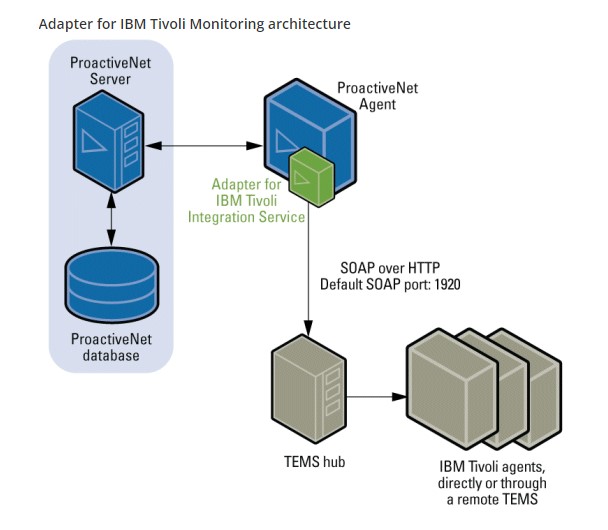
30. What is Tivoli Storage Manager (TSM)?
Ans:
The part of the IBM Tivoli suite focused on data protection and backup. It provides centralized backup, archive, and restore functions for servers in a network. IBM rebranded its storage management solutions under the IBM Spectrum umbrella, and Tivoli Storage Manager is one of the products included in the IBM Spectrum suite. IBM Spectrum Protect is designed to provide organizations with data protection and management capabilities, ensuring the backup, recovery, and archive of critical data.
31. What is the purpose of the IBM Tivoli Workload Scheduler (TWS)?
Ans:
- IBM Tivoli Workload Scheduler automates and manages batch processing and job scheduling across different platforms, ensuring efficient and timely execution of business processes.
- IBM Workload Scheduler aims to provide a robust and flexible solution for automating and optimizing batch-processing activities in complex IT environments.
- It helps organizations achieve operational efficiency and ensure the reliable execution of business-critical processes.
32. Explain the role of the Tivoli Enterprise Portal (TEP).
Ans:
Tivoli Enterprise Portal is a web-based user interface that allows administrators and operators to access and manage information from various Tivoli Monitoring components in a centralized and customizable dashboard. Theyyprovideadministrators and operators with the tools and visibility needed to ensure their IT infrastructure’s health, performance, and reliability.
33. How does IBM Tivoli Impact address IT operations?
Ans:
IBM Tivoli Impact helps understand the impact of IT events on business services. It correlates and analyzes events to provide a holistic view of the impact on the organization’s services. It focuses on helping organizations manage and gain insights from the vast data generated by IT infrastructure and applications. e of Tivoli Configuration Manager (TCM).
34. Explain the role of Tivoli Configuration Manager (TCM).
Ans:
TCM is used for automating tracking and managing configuration changes in an IT environment. It helps in maintaining consistency and compliance. Tivoli Configuration Manager (TCM), part of the IBM Tivoli suite, addresses configuration management needs within an IT environment. Please note that IBM’s product names and features may have evolved, and it’s advisable to refer to the latest IBM documentation for the most up-to-date information.
35. Discuss the role of IBM Tivoli Asset Discovery for Distributed (TAD4D) in asset management.
Ans:
IBM Tivoli Asset Discovery for Distributed (TAD4D) plays a crucial role in asset management by automating the discovery and tracking of IT assets. It provides a detailed inventory, aids in configuration management, ensures license compliance, supports the asset lifecycle, enhances security, and contributes to overall operational efficiency through automation.
36. What is IBM Tivoli Identity Manager (TIM)?
Ans:
IBM Tivoli Identity Manager is a product that helps organizations manage user identities and access privileges centrally, ensuring security and compliance. It falls under the broader Identity and Access Management (IAM) solutions category. Please note that product names and features may have evolved, so it’s advisable to refer to the latest IBM documentation for the most up-to-date information.
37. Explain the key components of IBM Tivoli Monitoring.
Ans:
IBM Tivoli Monitoring consists of components like Tivoli Enterprise Monitoring Server (TEMS), Tivoli Enterprise Portal Server (TEPS), and Tivoli Enterprise Portal Desktop (TEPD), among others. TEMS is responsible for data collection, TEPS provides a web-based interface, and TEPD is the desktop client.so it’s advisable to refer to the latest IBM documentation for the most up-to-date information.
38. Explain the concept of Self-Service Portals in IBM Tivoli Service Request Manager (TSRM).
Ans:
- Self-Service Portals in IBM Tivoli Service Request Manager (TSRM) empower users to independently submit and track service requests.
- Users can access information, submit requests, and check statuses without direct IT assistance.
- These portals streamline workflows, enhance user satisfaction, and contribute to efficient IT service delivery.
39. What is IBM Tivoli Identity Manager used for?
Ans:
IBM Tivoli Identity Manager is used for identity management and provisioning. It helps organizations manage user identities access permissions and ensures compliance with security policies. Identity management is a crucial aspect of cybersecurity and IT governance, and TIM is designed to address various challenges associated with managing user identities and access privileges.
40. How does IBM Tivoli Configuration Manager assist in IT infrastructure management?
Ans:
Tivoli Configuration Manager automates the collection and management of configuration information for IT assets. It helps maintain consistency, track changes, and enforce compliance with configuration policies. IBM Tivoli Configuration Manager (ITCM), now part of the broader IBM Endpoint Manager solution, is designed to assist in IT infrastructure management by providing configuration management, compliance assessment, and automated remediation capabilities.
41. Explain the role of the IBM Tivoli Workload Scheduler.
Ans:
Tivoli Workload Scheduler is used for job scheduling and workload automation. It allows organizations to automate and manage complex workflows, ensuring timely execution of tasks and efficient resource utilization. The robust job scheduling and workload automation solution is designed to help organizations manage and control the execution of tasks and processes across their IT infrastructure.
42. What is the purpose of IBM Tivoli Endpoint Manager?
Ans:
IBM Tivoli Endpoint Manager is designed for endpoint security and management. It helps organizations manage and secure devices across the network, including patch management and software distribution.TWS enables the automation of complex workflows, allowing for efficient resource utilization, improved job throughput, and better overall IT operational efficiency.
43. How does IBM Tivoli Access Manager enhance security?
Ans:
Tivoli Access Manager provides access control and authentication services. It helps organizations protect resources by controlling user access, enforcing security policies, and managing authentication processes. It allows organizations to implement security policies, protect sensitive data, and ensure users have appropriate access to resources based on their roles and contextual information.
44. Can you explain the role of IBM Tivoli Business Service Manager?
Ans:
- Tivoli Business Service Manager provides a consolidated view of business services and their dependencies.
- It helps organizations monitor and manage IT services from a business perspective, facilitating better decision-making.
- TBSM is designed to provide a consolidated and holistic view of IT services, enabling organizations to monitor, manage, and optimize business services by aligning IT operations with business objectives.
45. Explain the key components of IBM Tivoli Monitoring (ITM).
Ans:
ITM consists of Tivoli Enterprise Portal, Tivoli Enterprise Monitoring Server, Tivoli Management Server, and Tivoli Managed Nodes. The portal provides a central interface for monitoring, while the server components manage data collection, processing, and communication. Integrating agents, servers, reporting tools, and user interfaces makes IBM Tivoli Monitoring a powerful solution for monitoring diverse IT environments.
46. How does IBM Tivoli Identity Manager (TIM) contribute to security?
Ans:
TIM helps manage user identities and access permissions in an organization. It provides user provisioning, de-provisioning, and access governance capabilities to ensure security and compliance. A critical component of an organization’s security infrastructure focusing digital identities, providing appropriate access levels, and enforcing security policies.
47. Explain the purpose of the IBM Tivoli Workload Scheduler (TWS).
Ans:
TWS is designed to automate and optimize batch processing in a heterogeneous computing environment. It allows organizations to schedule and manage complex workflows, reducing manual intervention and improving efficiency. Enables the automation of complex workflows, allowing for streamlined execution of tasks and processes across diverse IT environments.
48. Describe the role of IBM Tivoli Configuration Manager (ITCM).
Ans:
ITCM helps organizations manage and control changes to their IT infrastructure. It enables automated configuration management, ensuring consistency and compliance across the environment. By establishing and enforcing configuration standards, ITCM contributes to the IT environment’s stability, security, and compliance. It aids in reducing the risk of misconfigurations, enhancing operational efficiency, and supporting overall IT governance.
49. How does IBM Tivoli Access Manager (ITAM) enhance security?
Ans:
ITAM provides centralized access management and control. It helps organizations secure resources by enforcing access policies, authentication, and authorization. Now part of the broader IBM Security Verify Access enhances security by providing robust identity and access management capabilities.
50. What is IBM Tivoli Composite Application Manager (ITCAM)?
Ans:
ITCAM is designed to monitor and manage application performance in a complex, multi-tier environment. It provides insights into application performance to ensure optimal user experience. Provides end-to-end visibility into the performance and health of applications, enabling organizations to proactively identify and address issues that may impact the user experience.
51. How does IBM Tivoli integrate with other enterprise systems?
Ans:
IBM Tivoli products often provide APIs and connectors to integrate with other enterprise systems, allowing seamless data exchange and interoperability. This integration is crucial for creating a holistic and efficient IT management environment. The integration capabilities of IBM Tivoli products are essential for creating a cohesive and interoperable IT management ecosystem.
52. Explain the role of the Tivoli Storage Manager (TSM).
Ans:
Tivoli Storage Manager is designed for data protection and recovery. It provides backup, archive, and restore functions for servers, desktops, and laptops in a network.TSM offers comprehensive backup, recovery, and archive features across diverse IT environments.
53. How does Tivoli Access Manager enhance security?
Ans:
- Tivoli Access Manager is used for authentication and authorization in a network environment.
- It controls user access to resources and helps in enforcing security policies.
- Now part of the broader IBM Security Verify Access offering, it enhances security by providing a robust identity and access management solution.
- ITAM helps organizations control user access to applications and resources, enforce security policies, and protect sensitive information.
54. What is the Tivoli Configuration Manager responsible for?
Ans:
Tivoli Configuration Manager is used for managing and maintaining the configuration of IT infrastructure components. It ensures that configurations are consistent and compliant with policies.IBM Tivoli Configuration Manager (ITCM), part of the broader IBM Tivoli suite (now integrated into IBM Security and Automation solutions), is responsible for configuration management within an organization’s IT infrastructure.
55. Explain the concept of ITM (IBM Tivoli Monitoring) Agents?
Ans:
ITM Agents are software components that collect data from various sources, such as servers or applications, and send it to the Tivoli Monitoring server for analysis and reporting. These agents act as data collectors, capturing information about various aspects of the monitored environment, including hardware, operating systems, applications, and network devices.
56. How does Tivoli Impact Business Continuity and Disaster Recovery?
Ans:
Tivoli products, such as Tivoli Storage Manager, play a crucial role in business continuity by providing robust backup and recovery solutions. These agents act as data collectors, capturing information about various aspects of the monitored environment, including hardware, operating systems, applications, and network devices. The collected data is then used for monitoring, analysis, and reporting within the ITM framework.
57. What are some common challenges in implementing and managing IBM Tivoli solutions?
Ans:
Challenges may include complex configurations, integration with existing systems, ensuring scalability, and keeping up with updates and patches. Engaging with experienced consultants, leveraging vendor resources, and participating in user communities can also provide valuable insights and assistance in overcoming implementation and management challenges.
58. What are the critical components of IBM Tivoli Monitoring?
Ans:
IBM Tivoli Monitoring comprises components such as, the Tivoli Enterprise Monitoring Server (TEMS), Tivoli Enterprise Portal Server (TEPS), and agents for monitoring different types of resources.ITM consists of several vital components that work together to collect, analyze, and present monitoring data. IBM Tivoli Monitoring (ITM) is a comprehensive solution for monitoring and managing the performance and availability of IT environments.
59. Explain the purpose of the Tivoli Enterprise Monitoring Server (TEMS).
Ans:
- TEMS is responsible for collecting and processing performance and availability data from agents, generating alerts, and storing historical data.
- It acts as a central point for monitoring in the Tivoli environment.
- It plays a crucial role in the overall architecture of ITM by serving as a central server responsible for receiving, processing, and managing monitoring data from various sources.
60. What is the Tivoli Enterprise Portal (TEP)?
Ans:
TEP is a web-based interface that provides a centralized view of the entire IT infrastructure. It allows users to monitor and manage resources, view alerts, and analyze historical data.TEP provides a unified view of the IT environment, enabling users to monitor performance, analyze data, configure settings, and respond to events and alerts.
61. How does IBM Tivoli Configuration Manager help in IT asset management?
Ans:
Tivoli Configuration Manager helps in managing and maintaining an inventory of IT assets. It automates the discovery, tracking, and reporting of hardware and software configurations in the IT environment. Plays a significant role in IT asset management by providing capabilities to discover, track, and manage software and hardware assets within an organization’s IT environment.
62. What is IBM Tivoli Storage Manager (TSM) used for?
Ans:
Tivoli Storage Manager is designed for backup, archive, and restore functions. It helps protect and manage data across different storage devices and platforms. IBM Tivoli Storage Manager (TSM), now known as IBM Spectrum Protect, is a data protection and backup solution designed to safeguard and manage an organization’s critical data.
63. How does Tivoli Identity Manager enhance security?
Ans:
- Tivoli Identity Manager centralizes the management of user identities and access rights.
- It helps enforce security policies, provision, and de-provision user accounts and ensure compliance with regulatory requirements.
- TSM provides comprehensive features to protect data, ensure its availability, and facilitate recovery in case of data loss or disasters.
64. Discuss the role of IBM Tivoli Netcool in IT operations management.
Ans:
Tivoli Netcool provides real-time event management and correlation. It helps identify and prioritize critical events, reduce the noise from non-critical events, and improve the overall efficiency of IT operations. It provides a comprehensive set of tools for real-time monitoring, event correlation, and IT infrastructure management, enabling organizations to proactively detect and respond to issues, optimize performance, and ensure the availability of critical services.
65. How do you troubleshoot common issues in IBM Tivoli environments?
Ans:
Troubleshooting in IBM Tivoli involves reviewing log files, checking the status of services, and verifying configuration settings. Knowledge of common error messages and their resolutions is crucial for troubleshooting. Troubleshooting common issues in IBM Tivoli environments involves a systematic approach to identifying, diagnosing, and resolving problems that may arise in the various components of the Tivoli suite.
66. Explain the key components of IBM Tivoli Monitoring.
Ans:
IBM Tivoli Monitoring consists of components such as the Tivoli Enterprise Portal, Tivoli Monitoring Server, Tivoli Data Warehouse, and Tivoli Enterprise Monitoring Agents. These work together to collect, store, and analyze performance data from various IT resources.
67. How do you configure monitoring for a new server in IBM Tivoli Monitoring?
Ans:
To configure monitoring for a new server, you typically need to install and configure a Tivoli Monitoring Agent on the server. After that, you can use the Tivoli Enterprise Portal to define monitoring policies and thresholds for the specific resources on that server. This involves several steps to ensure that the server is discovered correctly and monitored and that relevant metrics are collected.
68. What is IBM Tivoli Storage Manager (TSM) and how does it work?
Ans:
Tivoli Storage Manager is a data protection and recovery solution. It works by storing and managing backup, archive, and space management copies of data across various devices, such as disk, tape, or cloud storage. TSM, now part of the IBM Spectrum Protect family, is known for its scalability, flexibility, and support for heterogeneous IT environments.
69. How do you troubleshoot issues with IBM Tivoli Monitoring agents?
Ans:
- Troubleshooting Tivoli Monitoring agents involves checking logs, verifying connectivity, and ensuring the agent configuration is correct.
- Examining the Tivoli Enterprise Monitoring Agent logs and using the provided diagnostic tools can help identify and resolve issues.
- Troubleshooting issues with IBM Tivoli Monitoring (ITM) agents involves a systematic approach to identifying, diagnosing, and resolving problems affecting the agents’ functionality.
70. How does IBM Tivoli Identity Manager contribute to security?
Ans:
Tivoli Identity Manager is designed to manage user identities, access permissions, and organizational roles. It helps enhance security by ensuring that only authorized individuals have access to specific resources and provides tools for managing and auditing user privileges.
71. Explain the role of the IBM Tivoli Workload Scheduler.
Ans:
Tivoli Workload Scheduler automates the scheduling and management of batch processing workloads across different platforms. It helps optimize resource utilization and ensures timely execution of critical tasks.TWS is now part of the IBM Workload Automation (WA) family. Its primary role is to optimize the execution of workload processes, ensuring timely and efficient completion of tasks within an organization.
72. Explain Tivoli Storage Manager (TSM).
Ans:
IBM Tivoli Storage Manager (TSM) is an enterprise-level data protection and backup solution that provides centralized management, backup, and data recovery across various platforms and environments.TSM is a data protection platform that offers centralized backup and recovery management. It supports multiple backup methods and ensures data integrity.
73. What is Tivoli Configuration Manager (ITM) used for?
Ans:
- Tivoli Configuration Manager is used for automating the discovery, tracking, and management of hardware and software configurations in an IT environment.
- There may be a slight confusion in your question. Tivoli Configuration
- Manager (ITM) and IBM Tivoli Monitoring (ITM) are different products within the broader IBM Tivoli suite.
74. How does the Tivoli Workload Scheduler contribute to IT automation?
Ans:
Tivoli Workload Scheduler automates and schedules batch processing tasks, reducing manual intervention and improving the efficiency of IT operations.IBM Tivoli Workload Scheduler (TWS) plays a crucial role in IT automation by automating and orchestrating complex workflows, job scheduling, and workload processes across diverse IT environments.
75. What are some common challenges in implementing IBM Tivoli solutions?
Ans:
Challenges may include:
- Integration issues with existing systems.
- Ensuring proper configuration.
- Adapting to changes in the IT environment.
76. How do you troubleshoot issues in Tivoli environments?
Ans:
Troubleshooting issues in Tivoli environments involves a systematic approach to identifying, diagnosing, and resolving problems affecting Tivoli products’ performance, configuration, or functionality. Troubleshooting involves analyzing logs, using monitoring tools, and following best practices. Knowledge of the specific Tivoli component and its configuration is crucial.
77. Can you explain the critical components of IBM Tivoli Monitoring (ITM)?
Ans:
IBM Tivoli Monitoring includes components such as the Tivoli Enterprise Portal, Tivoli Enterprise Monitoring Server, Tivoli Enterprise Portal Server, and Tivoli Data Warehouse. These components collect, analyze, and display performance and availability data from monitored resources. It offers a range of components that work together to collect, research, and present monitoring data.
78. What is the purpose of IBM Tivoli Configuration Manager (ITCM)?
Ans:
IBM Tivoli Configuration Manager is designed for automated configuration management. It helps organizations maintain consistency in their IT environments by automating configuration changes, ensuring policy compliance, and tracking configuration history. The primary purpose of IBM Tivoli Configuration Manager is to provide a centralized and automated solution for configuration management, ensuring consistency, compliance, and efficient administration across the IT infrastructure.
79. How does IBM Tivoli Identity Manager (ITIM) contribute to security management?
Ans:
IBM Tivoli Identity Manager is focused on identity and access management. It automates creating, modifying, and deleting user accounts across various systems and applications, helping organizations securely manage user identities and access privileges. Its primary focus is managing user identities, access rights, and provisioning/de-provisioning processes.
80. Explain the purpose of IBM Tivoli Storage Manager (TSM).
Ans:
IBM Tivoli Storage Manager is a data protection and recovery solution. It enables organizations to back up, archive, and restore data from servers, workstations, and other devices, ensuring data availability and integrity. It addresses the challenges associated with data growth, disaster recovery, and regulatory compliance, providing organizations with the tools to safeguard and manage their valuable data assets.
81. How do you configure and manage agents in IBM Tivoli Monitoring?
Ans:
Agents in IBM Tivoli Monitoring are configured using the Agent Configuration tool. This tool allows you to set parameters such as communication settings, logging, and monitoring policies for the agents. There are several steps to ensure the monitoring agents are correctly installed, configured, and monitored.
82. What is the role of the Tivoli Enterprise Portal (TEP) in ITM?
Ans:
The Tivoli Enterprise Portal provides a centralized web-based interface for administrators and operators to monitor and manage the IT environment. It offers customizable views, real-time data, and event management capabilities. It provides a unified and customizable console for monitoring and managing the IT infrastructure.
83. How does IBM Tivoli Netcool contribute to network management?
Ans:
IBM Tivoli Netcool is a suite of products for event and network management. It collects and consolidates events from various sources, performs event correlation, and provides a unified view of network events to help identify and resolve issues quickly. Its primary focus is enhancing network and service operations’ visibility, control, and automation.
84. Explain the concept of policies in IBM Tivoli Configuration Manager.
Ans:
Policies in IBM Tivoli Configuration Manager define rules and standards for configuration settings. Policies can be used to automate configuration changes and maintain consistency. The concept of policies in Tivoli Configuration Manager revolves around creating, managing, and applying rules and configurations to ensure consistency, compliance, and security within the environment.
85. How do you troubleshoot performance issues in IBM Tivoli Monitoring?
Ans:
Troubleshooting performance issues in IBM Tivoli Monitoring involves analyzing performance data, reviewing logs, and checking the configuration of monitoring components. The Tivoli Enterprise Portal and other monitoring tools provide insights into resource utilization and performance metrics.
86. Explain the concept of IBM Tivoli Enterprise Console (TEC).
Ans:
- TEC is an event management solution that consolidates and correlates events from various sources in an enterprise.
- It provides a centralized console for monitoring and managing events, helping organizations quickly identify and respond to issues.
- TEC is designed to aggregate, correlate, and present information about events generated by various components and applications within an enterprise.
87. What is IBM Tivoli Access Manager (TAM)?
Ans:
Tivoli Access Manager is a security solution that controls user access to web applications and resources. It provides authentication, authorization, and auditing features to ensure secure and compliant access. It offers tools and capabilities to secure and manage access to web-based applications and resources within an organization’s IT environment.
88. How does IBM Tivoli Workload Scheduler (TWS) help in job scheduling?
Ans:
TWS automates and manages the scheduling of batch-processing tasks and jobs in a distributed computing environment. It helps optimize workload processing, ensuring efficient resource utilization.TWS helps organizations automate and optimize their workload by providing a centralized job scheduling, monitoring, and management platform.
89. Explain the role of IBM Tivoli Configuration Manager (ITCM) in IT asset management.
Ans:
ITCM automates the discovery and management of hardware and software assets in an IT environment. It helps organizations maintain accurate inventory, enforce compliance, and optimize resource usage. It enables administrators to effectively track, monitor, and keep the configuration of hardware and software components across the entire IT infrastructure.
90. What is the significance of IBM Tivoli Service Request Manager (TSRM)?
Ans:
TSRM is a service desk and request management solution that facilitates the efficient handling of service requests, incidents, and problems. It streamlines IT service delivery and enhances customer satisfaction. It significantly reduces efficient service request handling, improves communication between IT teams and end-users, and enhances overall service delivery.
91. Explain the key components of IBM Tivoli Monitoring (ITM).
Ans:
IBM Tivoli Monitoring consists of several key components, including Tivoli Enterprise Monitoring Server (TEMS), Tivoli Enterprise Portal Server (TEPS), Tivoli Data Warehouse (TDW), and agents deployed on monitored systems. TEMS collects and processes monitoring data, TEPS provides a web-based interface, and TDW stores historical data for reporting.
92. What is Tivoli Storage Manager (TSM), and its purpose?
Ans:
Tivoli Storage Manager is a data protection and recovery solution that provides backup, archive, and space management for various data types. It ensures data integrity and helps organizations recover from data loss or disasters. Its purpose is to provide a comprehensive and scalable solution for managing data backup, archive, and recovery in diverse IT environments.
93. Explain the purpose of IBM Tivoli Identity Manager (TIM).
Ans:
IBM Tivoli Identity Manager is designed to manage user identities and access privileges across an organization. It helps automate creating, updating, and deleting user accounts and ensures that users have appropriate access rights.IBM Tivoli Identity Manager (TIM) is an identity management solution designed to streamline and automate managing user identities, access rights, and entitlements across an organization’s IT infrastructure.
94. Explain the purpose of the Tivoli Workload Scheduler (TWS).
Ans:
Tivoli Workload Scheduler is designed to automate and optimize batch processing and workload scheduling across a diverse IT environment. It helps organizations manage and control the execution of processes, ensuring efficient resource utilization. The primary purpose of the Tivoli Workload Scheduler is to improve operational efficiency, reduce manual intervention, and ensure the timely and reliable execution of critical workloads.
95. How can you troubleshoot issues in IBM Tivoli products?
Ans:
Troubleshooting in IBM Tivoli involves reviewing log files, analyzing error messages, and using diagnostic tools provided by each product. Understanding the product architecture and configuration settings is crucial for identifying and resolving issues effectively.
96. Explain the purpose of IBM Tivoli Monitoring.
Ans:
- IBM Tivoli Monitoring is designed to monitor the performance and availability of IT resources proactively.
- It helps organizations identify and address potential issues before they impact the business.
- The primary purpose of IBM Tivoli Monitoring is to provide organizations with a centralized and proactive approach to monitoring their IT infrastructure, applications, and services.
- By collecting and analyzing real-time data, ITM helps identify and address potential issues before they impact system performance or disrupt critical business processes.
97. How does IBM Tivoli Identity Manager contribute to IT security?
Ans:
IBM Tivoli Identity Manager manages tormanageies and access privileges across an organization. It helps ensure that only authorized individuals have access to specific resources, enhancing security. It addresses user identities, access rights, and entitlements within an organization’s IT infrastructure.
98. Explain the role of IBM Tivoli Netcool in IT operations.
Ans:
Tivoli Netcool is an event and network management solution. It collects and analyzes events from various sources to help IT teams identify and respond to issues affecting the network and applications. Its role in IT operations is critical for ensuring network, application, and service availability, performance, and reliability.
99. How does IBM Tivoli help in IT Service Management (ITSM)?
Ans:
IBM Tivoli supports ITSM by providing tools for monitoring, automating, and managing IT services. It helps organizations align IT services with business objectives and deliver high-quality service to end-users. These solutions help align IT services with business needs, improve service delivery, and ensure efficient and effective IT operations.
100. Explain the purpose of IBM Tivoli Configuration Manager.
Ans:
Tivoli Configuration Manager is designed to automate and manage the configuration of IT resources across an organization. It helps ensure consistency and compliance by tracking changes, enforcing policies, and facilitating the deployment of configurations. The primary purpose of IBM Tivoli Configuration Manager is to help organizations manage, track, and enforce consistency in configuring their IT assets.


